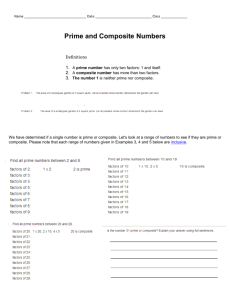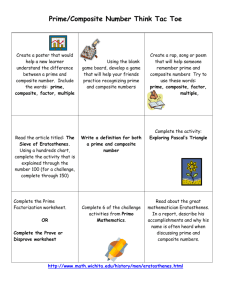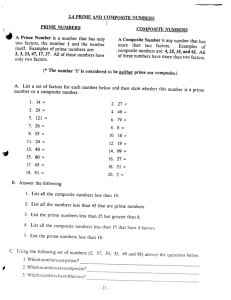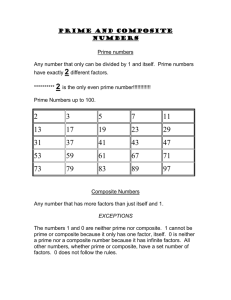Prime or composite
advertisement
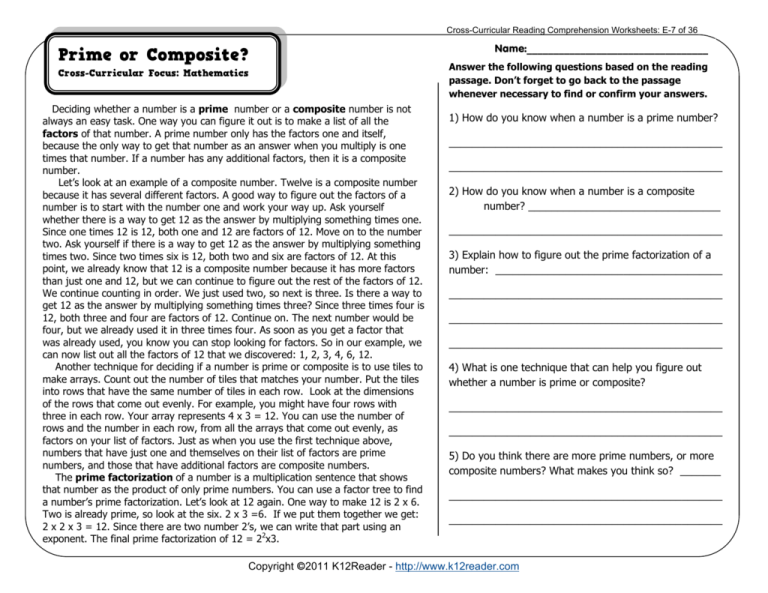
Cross-Curricular Reading Comprehension Worksheets: E-7 of 36 Prime or Composite? Cross-Curricular Focus: Mathematics Deciding whether a number is a prime number or a composite number is not always an easy task. One way you can figure it out is to make a list of all the factors of that number. A prime number only has the factors one and itself, because the only way to get that number as an answer when you multiply is one times that number. If a number has any additional factors, then it is a composite number. Let’s look at an example of a composite number. Twelve is a composite number because it has several different factors. A good way to figure out the factors of a number is to start with the number one and work your way up. Ask yourself whether there is a way to get 12 as the answer by multiplying something times one. Since one times 12 is 12, both one and 12 are factors of 12. Move on to the number two. Ask yourself if there is a way to get 12 as the answer by multiplying something times two. Since two times six is 12, both two and six are factors of 12. At this point, we already know that 12 is a composite number because it has more factors than just one and 12, but we can continue to figure out the rest of the factors of 12. We continue counting in order. We just used two, so next is three. Is there a way to get 12 as the answer by multiplying something times three? Since three times four is 12, both three and four are factors of 12. Continue on. The next number would be four, but we already used it in three times four. As soon as you get a factor that was already used, you know you can stop looking for factors. So in our example, we can now list out all the factors of 12 that we discovered: 1, 2, 3, 4, 6, 12. Another technique for deciding if a number is prime or composite is to use tiles to make arrays. Count out the number of tiles that matches your number. Put the tiles into rows that have the same number of tiles in each row. Look at the dimensions of the rows that come out evenly. For example, you might have four rows with three in each row. Your array represents 4 x 3 = 12. You can use the number of rows and the number in each row, from all the arrays that come out evenly, as factors on your list of factors. Just as when you use the first technique above, numbers that have just one and themselves on their list of factors are prime numbers, and those that have additional factors are composite numbers. The prime factorization of a number is a multiplication sentence that shows that number as the product of only prime numbers. You can use a factor tree to find a number’s prime factorization. Let’s look at 12 again. One way to make 12 is 2 x 6. Two is already prime, so look at the six. 2 x 3 =6. If we put them together we get: 2 x 2 x 3 = 12. Since there are two number 2’s, we can write that part using an exponent. The final prime factorization of 12 = 22x3. Name:__________________________________ Answer the following questions based on the reading passage. Don’t forget to go back to the passage whenever necessary to find or confirm your answers. 1) How do you know when a number is a prime number? _______________________________________________ _______________________________________________ 2) How do you know when a number is a composite number? _________________________________ _______________________________________________ 3) Explain how to figure out the prime factorization of a number: _______________________________________ _______________________________________________ _______________________________________________ _______________________________________________ 4) What is one technique that can help you figure out whether a number is prime or composite? _______________________________________________ _______________________________________________ 5) Do you think there are more prime numbers, or more composite numbers? What makes you think so? _______ _______________________________________________ _______________________________________________ Copyright ©2011 K12Reader - http://www.k12reader.com

